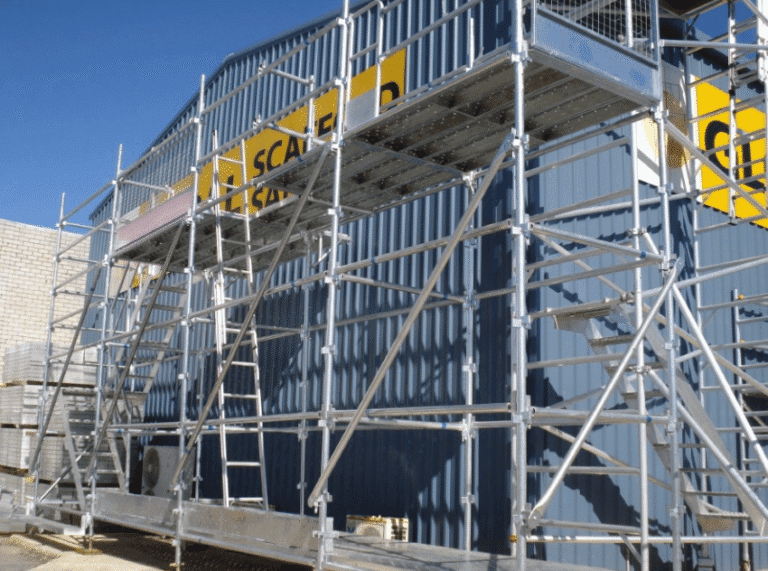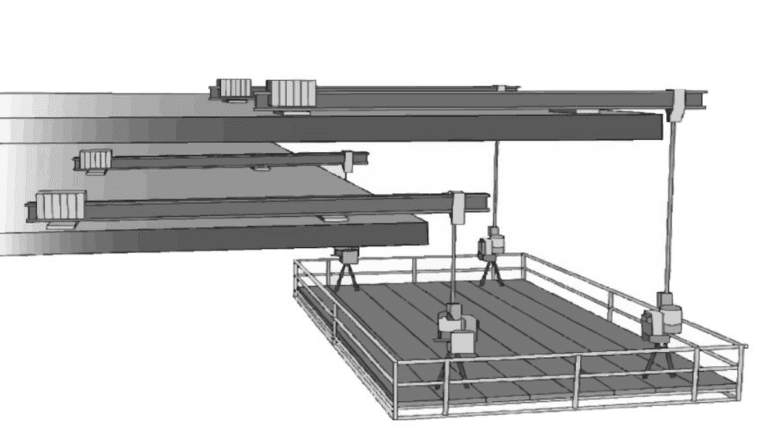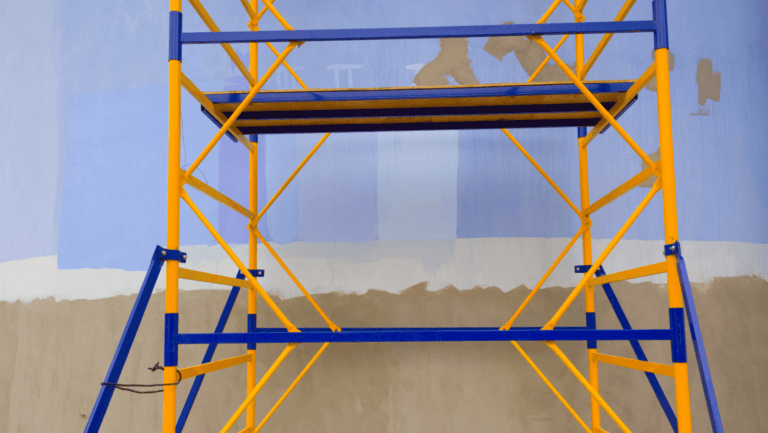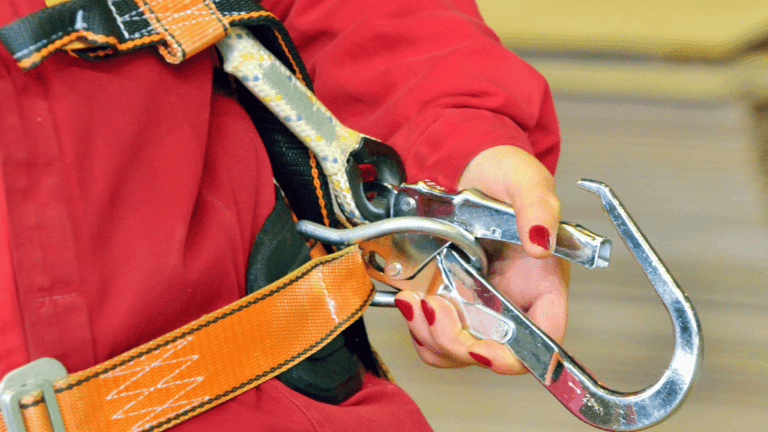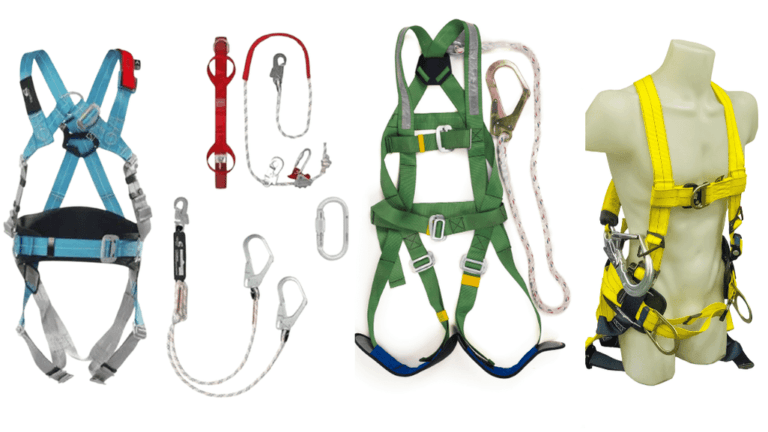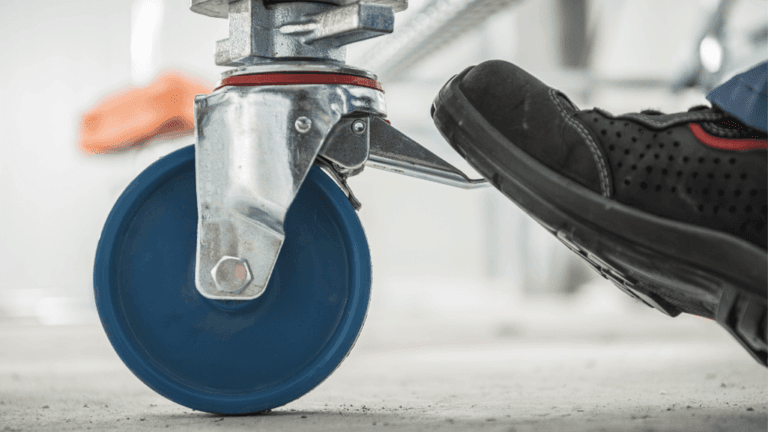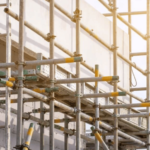Phone:
(+65)8319-0742
In the world of construction and maintenance, ensuring safe and efficient work access is paramount. When it comes to working on stairways, having the right stair scaffold is essential. Whether it’s for construction, renovation, or maintenance, a well-designed scaffolding for stairs can provide the secure access and stability needed to get the job done efficiently and effectively.
Key Takeaways:
- Stair scaffolds are crucial for ensuring safe and efficient work access on stairways.
- Proper scaffolding for stairs provides secure access and stability during construction and maintenance tasks.
- Investing in a high-quality stair scaffold system is important for optimal work performance.
- Following proper usage and safety guidelines is essential to ensure secure access and completion of projects.
- Choosing the right stair scaffold depends on project requirements and specific needs.
The Importance of Stair Scaffolding
https://www.youtube.com/watch?v=NcdHc7lZjlE
When it comes to construction and maintenance tasks on stairways, having secure and efficient access is of utmost importance. That’s where stair scaffolding comes into play. Stair scaffolding systems are specifically designed to provide a safe and stable working platform for workers to carry out their tasks.
So why is stair scaffolding so important? Let’s take a closer look:
- Enhanced Safety: Stair scaffolding offers a secure and stable structure that helps prevent accidents and falls during work on stairways. It provides a solid foundation for workers to perform their tasks confidently, reducing the risk of injuries.
- Efficient Access: With a properly installed stair scaffold, workers can easily access different levels of a stairway, saving time and effort. This efficient access allows for quicker completion of tasks, ultimately increasing productivity.
- Customizable Solutions: Stair scaffolding systems are available in various configurations, allowing for customization based on specific project requirements. Whether it’s a small repair job or a large-scale construction project, there’s a suitable stair scaffold option to meet your needs.
- Flexibility and Portability: Some stair scaffolding systems are designed to be portable, making them easy to move and set up as needed. This flexibility ensures that workers have access to the scaffold wherever it’s required on the stairway.
To better understand the importance of stair scaffolding, let’s take a look at a real-world example:
Case Study: Secure and Efficient Access with Stair Scaffold
| Construction Project | Without Stair Scaffold | With Stair Scaffold |
|---|---|---|
| Stairway Repair | Difficult access due to unstable makeshift platforms | Secure and stable working platform on each step |
| New Staircase Construction | Unsafe working conditions on open stair treads | Safe and sturdy scaffolding providing complete coverage |
| Railing Installation | Restricted access to higher levels of the stairway | Efficient access to all areas for quick installation |
In both repair and construction scenarios, having a reliable stair scaffolding system significantly improves worker safety, allows for seamless access to all areas of the stairway, and ensures efficient completion of tasks.
Thus, when undertaking any work on stairways, it is crucial to prioritize the use of proper stair scaffolding systems. By providing secure and efficient access, these systems enable workers to carry out their tasks safely and effectively.
Types of Stair Scaffolds
When it comes to working on stairways, having the right scaffolding system is essential. Different types of stair scaffolds are available to suit various project requirements. Let’s take a closer look at three popular options: portable stair scaffold, adjustable stair scaffold, and stair scaffold platform.
1. Portable Stair Scaffold
The portable stair scaffold is designed for easy transportation and quick setup, making it ideal for projects that require frequent movement around stairways. This type of scaffold typically features lightweight materials, foldable design, and lockable wheels for increased mobility and convenience. With a portable stair scaffold, workers can efficiently access different sections of the stairway without compromising safety.
2. Adjustable Stair Scaffold
An adjustable stair scaffold offers versatility and adaptability to different stairway dimensions. It is designed with adjustable legs or telescopic mechanisms, allowing for precise height adjustment to match the specific stair angle or gradient. This type of scaffold ensures a secure and stable working platform, regardless of the stairway’s configuration. The adjustable feature makes it suitable for both residential and commercial applications.
3. Stair Scaffold Platform
A stair scaffold platform is specifically designed to provide a stable work area on stairways, ensuring safe access for workers. It typically consists of a durable platform surface and supports that can be securely attached to the stair treads. The platform may feature anti-slip properties or guardrails for enhanced safety. Stair scaffold platforms are commonly used in construction, maintenance, and renovation projects that involve staircases.
| Scaffold Type | Key Features | Applications |
|---|---|---|
| Portable Stair Scaffold | Lightweight, foldable design, lockable wheels | Maintenance, construction, remodeling |
| Adjustable Stair Scaffold | Height-adjustable legs, telescopic mechanisms | Residential, commercial, industrial |
| Stair Scaffold Platform | Durable platform, anti-slip surfaces, guardrails | Construction, maintenance, renovation |
Understanding the different types of stair scaffolds available allows project managers and workers to select the most suitable option based on their specific needs. Whether it’s the portability of a portable stair scaffold, the adjustability of an adjustable stair scaffold, or the stability of a stair scaffold platform, having the right equipment ensures efficient and safe work access on stairways.
Components of a Stair Scaffold System

When it comes to ensuring safe and efficient work access on stairways, a comprehensive stair scaffold system is essential. This section will explore the various components that make up such a system, including the necessary equipment and accessories required to create a secure and stable work platform.
Stair Scaffolding Equipment
Stair scaffold systems are comprised of several key equipment pieces that work together to provide a stable and safe work environment. These include:
- The base: The base of a stair scaffold system provides a sturdy foundation and serves as the starting point for building upward.
- The frame: The frame consists of vertical and horizontal members that connect to form the scaffold structure. It provides stability and support for the entire system.
- The platform: The platform is the working surface where workers stand and perform tasks. It should be wide enough to accommodate the necessary tools and materials.
- The guardrails: Guardrails are essential safety features that prevent falls and provide a secure barrier around the work area.
- The handrails: Handrails offer additional support and stability for workers as they ascend and descend the stairs.
- Access ladder: An access ladder or stairway allows workers to safely enter and exit the scaffold system.
- Bracing: Bracing components reinforce the overall stability of the stair scaffold system to ensure it remains rigid and secure.
By combining these components, a stair scaffold system provides a safe and efficient solution for working on stairways. Whether it’s stair construction, maintenance, or repair, having the right equipment and accessories is crucial for a successful project.
Now that we’ve explored the components of a stair scaffold system, let’s move on to the advantages of using stair tower scaffolds in the next section.
Advantages of Stair Tower Scaffolds

Stair tower scaffolds are a game changer when it comes to providing enhanced stability and accessibility for stairway projects. Designed specifically for tackling construction and maintenance tasks on stairs, these specialized scaffolding systems offer numerous advantages that make them the best choice for efficient and safe work access.
Enhanced Stability
Stair tower scaffolds are built to provide exceptional stability, ensuring the safety of workers as they carry out tasks on stairways. With their sturdy construction and reliable support mechanisms, these scaffolds offer a secure platform for performing work at various heights.
Easy Installation and Versatility
One of the biggest advantages of stair tower scaffolds is their ease of installation. These systems are designed to be quickly assembled and disassembled, allowing for efficient project completion. Additionally, they are highly versatile, capable of adapting to different stair configurations, making them suitable for a wide range of projects.
Increased Accessibility
Stair tower scaffolds provide enhanced accessibility compared to traditional scaffolding systems. Their design allows workers to reach higher areas without the need for ladders or additional equipment, reducing the risk of accidents and improving overall efficiency.
Secure Work Environment
By utilizing stair tower scaffolds, workers can enjoy a secure work environment. These scaffolds feature guardrails and handrails that provide additional safety measures, minimizing the risk of falls or injuries. The stability and accessibility of stair tower scaffolds contribute to a safer workplace, ensuring that workers can carry out their tasks with peace of mind.
High Load Capacity
Stair tower scaffolds are designed to withstand heavy loads. They can support the weight of workers, equipment, and materials required for stairway projects. The high load capacity of these scaffolds makes them ideal for demanding construction and maintenance tasks.
Stair tower scaffolds truly offer the best solution for safe and efficient work access on stairways. Their advantages, such as enhanced stability, easy installation, increased accessibility, secure work environment, and high load capacity, make them a top choice for professionals in the industry.
Comparison Table: Stair Tower Scaffold vs. Traditional Scaffold
| Advantages | Stair Tower Scaffold | Traditional Scaffold |
|---|---|---|
| Enhanced Stability | â | â |
| Easy Installation | â | â |
| Increased Accessibility | â | â |
| Secure Work Environment | â | â |
| High Load Capacity | â | â |
Key Considerations When Buying a Stair Scaffold

When purchasing a stair scaffold system, it is essential to consider several key factors to ensure that you choose the right solution for your construction or maintenance projects. By carefully evaluating these considerations, you can invest in a stair scaffold that provides the necessary size, weight capacity, durability, and ease of assembly to meet your specific requirements.
Size: The size of the stair scaffold is crucial to ensure a secure fit and proper coverage of the stairway. Measure the dimensions of the stairs and choose a scaffold that will fit snugly and provide adequate access for your work.
Weight Capacity: It is important to know the weight capacity of the stair scaffold system you are considering. Ensure that it can safely support the weight of workers, tools, and equipment that will be used during the project. Exceeding the weight capacity can compromise the safety and stability of the scaffold.
Durability: Look for a stair scaffold made from high-quality materials that can withstand the rigors of construction and maintenance tasks. Opt for sturdy, rust-resistant materials that will provide long-lasting performance and ensure the safety of workers.
Ease of Assembly: Consider the ease of assembly when choosing a stair scaffold system. Look for user-friendly designs that can be easily set up and dismantled without the need for extensive training or complicated tools. A scaffold that is quick and easy to assemble will save time and effort on the job site.
By taking these key considerations into account, you can confidently purchase a stair scaffold system that meets your needs for safe and efficient work access on stairways.
Comparison of Key Considerations
| Consideration | Importance |
|---|---|
| Size | Crucial |
| Weight Capacity | Essential |
| Durability | Highly Important |
| Ease of Assembly | Significant |
As the table illustrates, each of these key considerations plays a vital role in selecting the right stair scaffold system. By carefully evaluating the importance of each factor and comparing different options, you can make an informed decision and purchase a stair scaffold that meets your specific needs.
Proper Usage and Safety Guidelines for Stair Scaffolding
When working with stair scaffolding equipment, it is crucial to follow proper usage and safety guidelines to ensure secure and efficient access for workers. By adhering to these best practices, you can minimize the risk of accidents, maximize productivity, and create a safe working environment.
1. Inspect and Maintain Equipment Regularly
Before each use, inspect the stair scaffolding for any damage or wear. Ensure that all components, such as frames, platforms, and guardrails, are in proper working condition. Address any issues promptly by repairing or replacing damaged parts. Regular maintenance will help prolong the lifespan of the equipment and ensure optimal safety.
2. Securely Install and Stabilize the Scaffold
Proper installation and stabilization of the stair scaffold are crucial for ensuring stability and preventing accidents. Follow the manufacturer’s instructions carefully to securely assemble the scaffold. Ensure that all locking mechanisms are engaged, and the scaffold is level and secure. Use adjustable legs or base plates to level the scaffold on uneven ground.
3. Use Personal Protective Equipment (PPE)
Always wear appropriate personal protective equipment while working with stair scaffolding. This may include a hard hat, safety glasses, gloves, and non-slip footwear. PPE helps protect you from potential hazards such as falls, falling objects, and injuries caused by tools or equipment.
4. Securely Position and Secure Tools and Materials
Ensure that all tools, materials, and equipment are securely positioned and properly stored on the scaffold. Use tool lanyards or tethering systems to prevent tools from falling. Avoid overloading the scaffold with excessive weight, as this can compromise its stability and increase the risk of accidents.
5. Maintain Clear and Safe Access Pathways
Keep the stairway and access points clear of obstacles, debris, and clutter. Maintain clear pathways to facilitate safe and efficient movement on and off the scaffold. Use guardrails and gates to prevent unauthorized access and ensure that workers can easily access the scaffold without hindrance.
6. Follow Safe Working Practices
Adhere to safe working practices while using stair scaffolding. Avoid leaning or reaching too far from the scaffold, as it can cause imbalance and increase the risk of falls. Use proper climbing techniques, such as facing the scaffold while ascending or descending, and always maintain three points of contact.
7. Monitor Weather Conditions
Pay attention to weather conditions, especially when working outdoors. High winds, rain, snow, or icy conditions can impact the stability of the scaffold and increase the risk of accidents. If adverse weather conditions arise, consider suspending work until conditions improve.
Remember, proper usage and adherence to safety guidelines are essential for the secure and efficient access provided by stair scaffolding equipment. By prioritizing safety and following these recommendations, you can create a productive and risk-free working environment for yourself and your team.
Maintenance and Inspection of Stair Scaffold Systems
Regular maintenance and inspections are crucial for ensuring the continued safety and reliability of stair scaffold systems. By conducting routine checks and addressing any issues promptly, you can enhance the overall performance and longevity of your stair scaffolding equipment. Here are some key maintenance and inspection practices to follow:
Routine Cleaning
Keeping your stair scaffold system clean is essential for preventing the buildup of dirt, debris, and other contaminants that can compromise its functionality. Regularly remove any obstructions, such as sawdust or construction materials, from the platform and supporting components. Use non-abrasive cleaning agents and soft brushes to avoid damaging the equipment during the cleaning process.
Inspecting Components
Regularly inspect all the components of your stair scaffold system to identify any signs of wear, damage, or malfunction. This includes checking the frames, braces, guardrails, ladder rungs, and locking mechanisms. Pay close attention to areas that experience high stress, such as connection points and joints. Any damaged or worn parts should be replaced immediately to ensure the safety and stability of the system.
Tightening Connections
Over time, the repeated use of a stair scaffold system can result in loosened connections and fasteners. It’s essential to periodically check and tighten all the nuts, bolts, and clamps to maintain the structural integrity of the equipment. Loose connections can compromise the stability and safety of the system, so regular tightening is vital.
Checking Anchorage
Verify that the stair scaffold system is securely anchored to the structure it is being used on. Ensure that the anchor points are stable and capable of supporting the weight and load applied to the system. Loose or weak anchor points can lead to instability and pose a significant safety risk to workers.
Documentation and Records
Keep detailed records of all maintenance and inspection activities performed on the stair scaffold system. This includes the dates of inspections, repairs made, and any replacement parts used. These records serve as a valuable reference and can help in identifying any recurring issues or patterns of wear.
By following these maintenance and inspection guidelines, you can ensure that your stair scaffold system remains in optimal condition, providing secure and efficient access for your work tasks.
Top Brands and Manufacturers of Stair Scaffolds
When it comes to choosing the best stair scaffold for your construction or maintenance project, opting for a reputable and reliable brand is crucial. With numerous options available in the market, it can be overwhelming to make the right decision. In this section, we will showcase some of the top brands and manufacturers of stair scaffolds, ensuring you have the information you need to buy the best stair scaffold for your specific requirements.
Durable Scaffold Co.
Durable Scaffold Co. is a renowned brand that specializes in high-quality stair scaffolds. Known for their durable and sturdy designs, their stair scaffolds provide excellent stability and secure work access. With their commitment to safety and innovation, Durable Scaffold Co. is an excellent choice for customers looking to invest in a reliable stair scaffold.
SafeAccess Solutions
SafeAccess Solutions is a trusted manufacturer of premium stair scaffolds. Their products are engineered to meet rigorous safety standards and ensure efficient work access on stairways. With a wide range of options available, they offer flexibility to accommodate various project needs. When purchasing a stair scaffold from SafeAccess Solutions, you can expect durability, reliability, and top-notch customer service.
AccessMasters
AccessMasters is a leading brand that specializes in producing state-of-the-art stair scaffolds. Their advanced designs prioritize worker safety and ease of use. AccessMasters stair scaffolds are known for their robust construction, allowing for secure and efficient access on stairways. With their commitment to continuous improvement and customer satisfaction, AccessMasters is a top choice for those seeking the best stair scaffold in the market.
While these are just a few examples of top brands and manufacturers, it’s important to thoroughly research and compare options before making a purchase. Consider factors such as quality, durability, ease of assembly, and customer reviews to ensure you choose the best stair scaffold for your project needs. Investing in a reliable and well-designed stair scaffold will not only enhance worker safety but also contribute to the overall efficiency and success of your stairway construction or maintenance project.
Conclusion
In conclusion, stair scaffold systems are essential for ensuring safe and efficient work access during stairway construction and maintenance tasks. These systems provide workers with the secure access they need to complete projects effectively and minimize the risks associated with working at heights.
When choosing a stair scaffold, it is crucial to conduct thorough research and compare different options available in the market. Consider factors such as size, weight capacity, durability, and ease of assembly to find a high-quality system that meets your specific project requirements.
Furthermore, it is vital to follow proper usage and safety guidelines when using stair scaffolding equipment. This includes ensuring the scaffold is properly assembled, securely anchored, and regularly inspected for any signs of damage or wear. By adhering to these guidelines, you can mitigate potential hazards and maintain a safe working environment.
Investing in a reliable stair scaffold system not only improves the safety of your workforce but also enhances the overall efficiency of your stairway projects. So, make an informed decision and prioritize the well-being of your workers by equipping them with the right tools for the job.
FAQ
What is a stair scaffold?
A stair scaffold is a specialized scaffold system that is designed specifically for providing safe and efficient access to stairways during construction and maintenance projects.
Why is stair scaffolding important?
Stair scaffolding is important because it ensures secure and efficient access to stairways, allowing workers to safely perform tasks at different heights and navigate the stairs with ease.
What types of stair scaffolds are available?
There are various types of stair scaffolds available, including portable stair scaffolds that can be easily moved and adjusted, adjustable stair scaffolds that offer flexibility in height and width, and stair scaffold platforms that provide a stable and level work surface on stairs.
What components make up a stair scaffold system?
A stair scaffold system typically includes components such as stair towers, stair risers, handrails, guardrails, locking mechanisms, and stabilizers. These components work together to provide a safe and secure work platform on stairways.
What are the advantages of using stair tower scaffolds?
Stair tower scaffolds offer enhanced stability and accessibility compared to traditional scaffolding systems. They are designed to fit securely on stairways and provide a safe and efficient work platform at different heights.
What should I consider when buying a stair scaffold?
When purchasing a stair scaffold system, it is important to consider factors such as the size and weight capacity of the scaffold, its durability and ease of assembly, and whether it meets the specific requirements of your project.
What are the safety guidelines for using stair scaffolding?
When using stair scaffolding, it is important to follow safety guidelines such as ensuring proper installation, using appropriate personal protective equipment, securing the scaffold to prevent movement, and conducting regular inspections for any signs of damage or instability.
How should I maintain and inspect my stair scaffold system?
Regular maintenance and inspections are crucial for the safety and reliability of a stair scaffold system. This includes checking for any loose or damaged components, ensuring proper functioning of locking mechanisms and stabilizers, and promptly addressing any issues or concerns.
Which are some top brands and manufacturers of stair scaffolds?
There are several reputable brands and manufacturers of stair scaffolds available in the market. Some popular options include Meta, Youngman, Werner, and Alulock. It is recommended to research and compare different brands to choose the best stair scaffold system for your specific needs.

Industrial Scaffolding Solutions & Services
Welcome to our comprehensive guide on industrial scaffolding solutions and services. In the field of…

Essential Construction Scaffolding Safety Tips
Ensuring construction site safety is of utmost importance when working with construction scaffolding….

Mobile Scaffold Solutions for Safe Work Access
Mobile scaffolds play a crucial role in providing safe work access on industrial job sites. These versatile…

Portable Scaffolding: Compact & Easy Setup
When it comes to construction projects and other tasks that require a safe and stable working platform,…

Top Scaffold Inspection Apps for Safety Compliance
Enhance overall safety and quality on construction sites with the help of scaffold inspection apps. These…
No posts found


